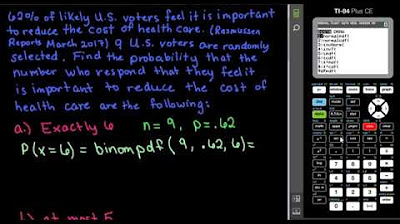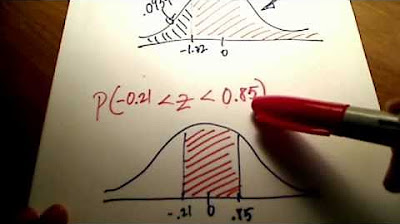5.2.3.2 Binomial Distributions - Find binomial probabilities using a table.
TLDRThis video script discusses four methods for calculating binomial probabilities. It highlights the limitations of using a table of probabilities, which can only be applied for 'n' less than or equal to 8 and specific success probabilities. The script revisits an example of guessing multiple-choice questions, demonstrating how to find the probability of getting exactly two correct answers out of four using the table method, resulting in a similar outcome to the formula approach. It also emphasizes the utility of technology for large 'n' values and assures that formulas and tables will be provided during exams, advocating for understanding the technology's role in real-world problem-solving.
Takeaways
- 📚 The script discusses four methods for computing binomial probabilities, with the fourth method being the use of a table of probabilities found in Appendix A of the textbook.
- 🚫 The table method has limitations, such as not being usable if 'n' is greater than 8 or if the probability is not one of the 13 values included in the table.
- 🔍 To use the table, one must identify the correct row for the number of trials 'n' and the correct column for the probability of success in one trial 'p', and find the isolated number representing the desired probability.
- 🧐 The script revisits an example where the probability of guessing exactly two correct answers out of four multiple-choice questions is calculated using the table method.
- 📈 The probability of success in one trial is given as 0.2 (one correct answer out of five), and the probability of failure is 0.8.
- 🔢 The script demonstrates how to look up the probability in the table, finding it to be 0.154, which is rounded from the calculated value of 0.1536.
- 📝 The first method mentioned for calculating binomial probabilities is the intuitive approach, which uses the multiplication and addition rules.
- 📉 The second method is using the formula for P(x), which is suitable for small values of 'n' and 'x' and is easy to use.
- 💻 The third method involves using technology, such as the binomial distribution function in Excel, which is recommended for large values of 'n'.
- 📊 Technology can be used to create an entire table of probabilities for a given number of trials, which is helpful for finding cumulative probabilities.
- 📋 During exams, students will have access to a sheet with Triola formulas and tables, including the formula for the probability of 'x' successes in 'n' trials, so memorization is not required.
- 🛠️ The script emphasizes the importance of understanding what technology is doing and using it to check answers while doing homework, as well as using formulas or tables during exams for exact answers.
Q & A
What are the four methods discussed in the script for computing binomial probabilities?
-The four methods discussed are: 1) the intuitive approach using the multiplication rule and addition rule, 2) using the formula for P(x), 3) using technology such as the binomial distribution function in Excel, and 4) using a table of binomial probabilities found in the textbook's appendix.
Why can't the table of probabilities be used if n is greater than 8 or if the probability is not one of the 13 values included in the table?
-The table of probabilities has limitations due to its design. It is only able to provide probabilities for a specific set of values for n and p. If n exceeds 8 or the probability p is not among the 13 listed values, the table cannot be used to find the exact probability.
What does the row in the table of binomial probabilities represent?
-The row in the table represents a particular number of trials (n) and a specific number of successes (x) in those n trials.
What does the column in the table of binomial probabilities represent?
-The column in the table represents the desired probability of success in one trial (p).
In the example given, what is the context of the binomial probability calculation?
-The context is guessing on multiple-choice questions where each question has five possible answers, only one of which is correct. The calculation is for the probability of getting exactly two correct answers out of four questions.
What is the probability of success (p) in the example with multiple-choice questions?
-The probability of success (p) is 0.2, as there is a one in five chance of selecting the correct answer for each question.
What is the probability of failure (q) in the example with multiple-choice questions?
-The probability of failure (q) is 0.8, as there are four incorrect options out of five, making the chance of choosing an incorrect answer 80%.
How does the script demonstrate the use of the table of binomial probabilities to find the probability of getting exactly two correct answers out of four?
-The script identifies n (4 trials), x (2 successes), and p (0.2), then looks up the corresponding value in the table of binomial probabilities to find the probability of exactly two successes, which is listed as 0.154 after rounding.
What is the significance of rounding in the context of the binomial probability table?
-Rounding is significant because the table lists probabilities rounded to three decimal places. This affects the precision of the result, as shown when comparing the table's rounded probability of 0.154 to the calculated probability of 0.1536.
Why is technology recommended for binomial probability calculations when n is large?
-Technology is recommended for large n because it can handle complex calculations more efficiently and accurately, especially when dealing with cumulative probabilities or a large number of trials, which would be impractical to calculate by hand or using a table.
What resources will be provided during an exam over this material?
-During the exam, students will have access to a sheet with Triola's formulas and tables, including the formula for the probability of x successes in n trials, so memorization is not required. Additionally, a table of probabilities can be printed out and used during the exam.
How does the script suggest using technology to check answers while doing homework?
-The script suggests using technology as a tool to verify the results obtained from manual calculations or using a table, ensuring accuracy and understanding of the process.
Outlines
📊 Using Binomial Probability Tables
This paragraph discusses the fourth method of computing binomial probabilities, which is utilizing a table of probabilities found in Appendix A of the textbook. It mentions the limitations of this method, such as it not being applicable for values of 'n' greater than 8 or for probabilities not listed in the table. The speaker explains how to use the table by identifying the correct row for the number of trials and successes, and the correct column for the desired probability of success in a single trial. The example provided involves guessing multiple-choice questions with five possible answers and calculating the probability of getting exactly two correct answers out of four, using the table to find the probability as 0.154, which is rounded from the exact calculation of 0.1536.
🛠️ Technology and Binomial Probability Calculations
The second paragraph elaborates on the use of technology for calculating binomial probabilities, especially when dealing with a large number of trials. The speaker suggests that while the intuitive approach and the formula are suitable for small 'n' and 'x' values, technology becomes invaluable for larger datasets. The paragraph also touches on the use of Excel's binomial distribution function to generate a table of probabilities. It emphasizes the importance of understanding what the technology is doing and the appropriateness of using formulas or tables during exams, as they provide the same exact answers as technology. The speaker reassures that for exams, students will have access to formulas and tables, and while technology is encouraged for real-world problem-solving, it will not be necessary for exam questions that require extensive calculations.
Mindmap
Keywords
💡Binomial Probabilities
💡Table of Probabilities
💡Appendix A
💡n (Number of Trials)
💡x (Number of Successes)
💡Probability of Success (p)
💡Probability of Failure (q)
💡Rounding
💡Intuitive Approach
💡Binomial Formula
💡Technology
💡Triola Formulas and Tables
Highlights
Introduction of four methods for computing binomial probabilities.
Limitations of using a table of probabilities for binomial calculations when n > 8 or when probability is not one of the 13 values included.
Explanation of how to use a table of probabilities by finding the right row and column to get the desired probability.
Example of calculating the probability of getting exactly two correct answers out of four multiple-choice questions, assuming guessing.
Explanation of the process to find the probability using the table of binomial probabilities and rounding to three decimal places.
Identification of n, x, p, and q for the binomial probability calculation in the given example.
Demonstration of looking up the probability in the table and comparing it to the result obtained through the formula.
Comparison between the intuitive approach, the formula, and the table for finding binomial probabilities.
Advantages of using technology for large n values in binomial probability calculations.
Discussion on the appropriateness of using technology for real-world problems and understanding what the technology is doing.
Availability of formulas and tables during exams for students to use instead of memorization.
Instruction on the use of a table of probabilities during exams and its limitations.
Emphasis on the importance of not overburdening students with complex calculations during exams.
Suggestion to use technology to check answers during homework to ensure accuracy.
Final summary of the methods for computing binomial probabilities and their practical applications.
Transcripts
Browse More Related Video

5.2.3.1 Binomial Distributions - Use Intuition, A Formula, and Technology to Find Probabilities

5.2.5 Binomial Probability Distributions - Using Probabilities to Determine Significance

Binomial Probability Using the TI-84

Constructing a probability distribution for random variable | Khan Academy

5.2.1 Binomial Probability Distributions - Is this procedure described by a binomial distribution?

Stats: Finding Probability Using a Normal Distribution Table
5.0 / 5 (0 votes)
Thanks for rating: